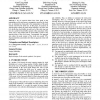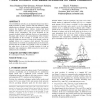17 search results - page 3 / 4 » Low-power clock trees for CPUs |
DAC
2005
ACM
15 years 1 months ago
2005
ACM
Although a lot of research efforts have been made in the minimization of the total power consumption caused by the clock tree, no attention has been paid to the minimization of th...
ISLPED
2010
ACM
14 years 12 months ago
2010
ACM
Structured ASICs provide an exciting middle ground between FPGA and ASIC design methodologies. Compared to ASIC, structured ASIC based designs require lower non recurring engineer...
DAC
2009
ACM
16 years 20 days ago
2009
ACM
Power and performance benefits of scaling are lost to worst case margins as uncertainty of device characteristics is increasing. Adaptive techniques can dynamically adjust the mar...
103
Voted
ASPDAC
2008
ACM
15 years 1 months ago
2008
ACM
Meeting power and performance requirement is a challenging task in high speed ALUs. Supply voltage scaling is promising because it reduces both switching and active power but it al...
GLVLSI
2009
IEEE
15 years 6 months ago
2009
IEEE
Clock distribution networks are an important design issue that is highly dependent on delay variations and load imbalances, while requiring power efficiency. Existing mesh solutio...



